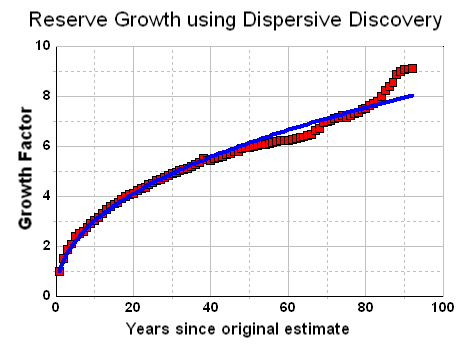Significant, no hyperbole
Does anybody else even look at this stuff? Here we have one of the biggest issues facing the world, that of peak oil, and we don't even know how to analyze the data. Sigh. Oh well, here we go once again.
Let us look at the Dispersive Discovery model and the relationship describing cumulative reserve growth for a region:
DD(t) = 1 / (1/L + 1/kt) => Ureserve(t)
From noting in the last post that this same dependence can occur for field sizes, I realized that an interesting mapping into reciprocal space makes these curves a lot easier to visualize and to extrapolate from. So instead of plotting t against U, we plot 1/t against 1/U
1/U(t) = 1/L + 1/ktOn a linear-linear x-y plot where x maps into 1/t and y into 1/U, the linear curve looks like this:

For field size distributions, it looks like this on a log-log plot. This shows up clearly as a straight line over the entire range of the reciprocal values for the variants, if you pull the constant term into one of the two variants. This works out very well for size distributions if we scale the values to an asymptotic cumulative probability of 1.

Laherrere has long referred to "hyperbolic" plots in fitting to creaming curves. If you Google for hyperbolic Laherrere, you will find several PDF files where he describes how well he can match the growth temporal behavior to one or more "hyperbolic" curves. However, I can find no mention of Laherrere's description or derivation of the hyperbolic other than its use as a heuristic. I posted about Laherrere's use of hyperbolic curves before without understanding what he meant by them. Even the thoroughly discredited cornucopian Michael Lynch could not find an explanation:
No explanation is given for the 'hyperbolic model' or why ordering by size is more appropriate than by date of discovery.I always assumed that a hyperbolic function either meant a slice through a conic section or this type of dependence:
y = 1 / x + c1 / y = 1 / x + cThe following graph shows a typical Laherrere creaming curve analysis, where he fits to a couple of hyperbolic functions. Note that he refers to "hyperbola" in the legend. As the mellon-colored curve I plot the Dispersive Discovery cumulative . I had to slide it off Laherrere's hyperbola curve slightly since the two match exactly, which means that you couldn't tell the two apart and one curve would obscure the other.

I have no doubt that Laherrere's hyperbolas map precisely into the linear Dispersive Discovery curves. I just find it unfortunate that it has taken this long to figure this key piece of the puzzle out. So we have turned the hyperbolic fit heuristic into a model which comes about from a well understood physical process, that of Dispersive Discovery.
On another positive note, I think the reciprocal fitting (Dispersion Linearization) may become just as popular as Hubbert Linearization. From what I have gathered, people seem to appreciate straight lines more than curves. Herewith, from a classic Simpson's episode:
Professor Frink: [drawing on a blackboard] Here is an ordinary square....I am currently reading one of Professor Deirdre McCloskey's rants against non-scientific method mumbo-jumbo and feel a bit better at fighting the good fight against using arbitrary heuristics and qualitative analysis. Yet, in the long run, will anyone really care unless you can simplify it to two points on a line segment?
Police Chief Wiggum: Whoa, whoa - slow down, egghead!









2 Comments:
At least some of us are reading...
I think you sprained my brain.
A sprain on the brain is nothing in comparison to the deep psychosis I risk in thinking through this stuff. I should really think about reserving a rubber room just in case ...
Post a Comment
<< Home